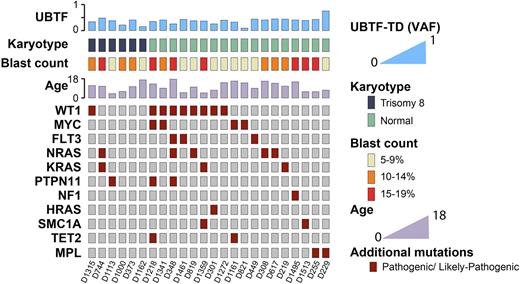Abstract
Introduction: Recurrent tandem duplications (TD) in exon 13 of the upstream binding transcription factor gene (UBTF) have recently been identified in 4% of pediatric AML (Umeda et al. 2022). UBTF-TD AMLs were associated with adolescent age, normal karyotype, trisomy 8, as well as FLT3-ITD and WT1 mutations. Response to chemotherapy was poor and probability of overall survival (OS) at 5 years only 44%. Here, we evaluate the role of UBTF-TD in pediatric MDS.
Methods: We studied 104 consecutive patients (pts) diagnosed with primary MDS with excess blasts below the age of 18 years enrolled in the prospective studies 98 or 2006 of the European Working Group of MDS in Childhood (EWOG-MDS) in Germany between July 1, 1998 and June 30, 2021. Pts with MDS secondary to chemo- or radiation therapy, acquired aplastic anemia and pts with classical inherited bone marrow failure disorder had been excluded from the analysis. High molecular weight DNA was extracted from stored bone marrow (BM) samples or archived smears. Screening for UBTF-TD was performed by PCR using 6-FAM-labelled primers covering exon 13 of the UBTF gene followed by high resolution fragment analysis. For samples showing aberrant signals indicating UBTF-TDs, Sanger sequencing confirmed the presence of a mutation. All UBTF mutant samples were also analyzed using targeted next generation sequencing (Archer Myeloid panel) for the presence of co-occurring alterations.
Results:UBTF-TDs were detected in 25 of the 104 pts (24%; 16 males/9 females), while 79 pts (76%; 45 males, 34 females) showed no UBTF mutation (UBTF-wt). Variant allelic frequencies of UBTF-TD ranged from 11%-79% (median 41%). Median age at diagnosis in UBTF-TD and UBTF-wt pts was not different (11.0 vs. 9.8 years). UBTF-TD pts had higher absolute neutrophil counts (2.7 vs. 0.9 x109/L, p=0.01) and more often normoblasts on peripheral blood smears (92% vs 43%, p<0.01). Blast percentage in BM was similar with <10% blasts in 40% and 38% of UBTF-TD and wt pts, respectively. BM cellularity was normal or increased in 92% of UBTF mutated pts compared to 72% of UBTF-wt pts (p<0.01). Cytogenetic analyses revealed striking differences according to UBTF mutational status with the following karyotypes (TD vs wt): normal (72% vs 33%), -7 (0% vs 30%), del(7q) (0% vs 2%), +8 (24% vs 9%), +8 plus other (0% vs 4%), random (4% vs 7%) and structural complex (0% vs 7%). Probability of OS at 5 years for pts with UBTF-TD was inferior (0.50, 0.28-0.72) to that of pts with UBTF-wt (0.73, 0.62-0.84; p=0.03).
Of the 104 pts, 30 pts had a genetic predisposition to myeloid neoplasia, i.e. GATA2 deficiency (n=15), RUNX1 deficiency (n=7), SAMD9/SAMD9L disease (n=6) or neurofibromatosis type 1 (n=2). Of note, none of the pts with predisposition harbored a UBTF-TD. To study the impact of UBTF-TD on outcome of hematopoietic stem cell transplantation (HSCT), pts with germline disease were excluded; of the 72 pts available for HSCT analysis (25 UBTF-TD and 47 UBTF-wt). Therapy prior to HSCT in UBTF-TD and UBTF-wt pts was comparable and consisted of AML-type therapy in 32% vs 21%, less intensive chemotherapy 8% vs 15% and no therapy in 60% vs 64% pts, respectively. Type of donor, stem cell source and conditioning regimen did not differ between the 2 groups, 74% of pts received a busulfan, cyclophosphamide and melphalan conditioning. Event-free survival (EFS) and relapse incidence (CIR) at 5 years of the total cohort were 0.55 (0.39-0.71) and 0.23 (0.15-0.36), respectively. There was no difference in EFS between the 25 UBTF-TD (0.43, 0.22-0.64) and 47 UBTF-wt pts (0.60, 0.45-0.75). However, in pts with normal karyotype, presence of an UBTF-TD was associated with an inferior EFS (0.35 vs. 0.77, p=0.03) and higher CIR compared to wt pts (0.36 vs. 0.06, p=0.03). Co-occurrence of WT1 mutations among UBTF mutated pts was associated with higher CIR (p=0.03); other mutations were less frequent (Figure).
Discussion: We identified UBTF-TD in a third of all pediatric pts with advanced primary MDS and absence of germline predisposition. In addition, we noted UBTF-TD at a high frequency in pediatric pts with MDS-related AML (3/15 pts UBTF-TD). In regards to the recent discovery in AML, we conclude that UBTF-TD mutations define a novel subgroup of myeloid neoplasia presenting frequently as pediatric MDS. The high CIR following HSCT particularly in patients with concurrent WT1 mutations outlines an urgent need for new therapeutic strategies.
Disclosures
Erlacher:Gilead Sciences: Research Funding. Niemeyer:BMS: Honoraria; Novartis: Honoraria; Apriligen LLC: Honoraria. Thiede:Jazz Pharmaceuticals: Membership on an entity's Board of Directors or advisory committees, Speakers Bureau; Janssen Pharmaceuticals: Speakers Bureau; Novartis: Honoraria, Membership on an entity's Board of Directors or advisory committees, Research Funding, Speakers Bureau; AgenDix GmbH: Current Employment, Current equity holder in private company; Kronos Bio, Inc.: Honoraria.
Author notes
Asterisk with author names denotes non-ASH members.


This feature is available to Subscribers Only
Sign In or Create an Account Close Modal